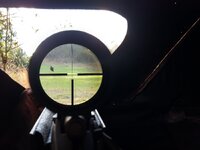Sure. But that really wasn’t the reason for this, or at least not the entire reason, and three of the five most useful scopes in this group were FFP- SWFA 3-9x, 3-15x, and ZP5. One does not have to suffer SFP to get a usable reticle on low power.
The main thing is- “does the difference from decent to good “glass”, to “really good glass” change what can be shot in low light? The answer is no- once decent brightness and clarity has been achieved, the failure is alsmit never due to “glass”. In one S2H class last year, guys were shooting over an hour after sunset (in the dark), and the determiner of who had trouble was reticle- not who was shooting the best “glass”.
Then the question becomes what is the failure? And that is primarily driven by reticle. SFP isn’t a cure all for this- there are lots of bad SFP reticles. Not many people complain about Leupold’s standard duplex in their scopes- yet the MQ reticle in the SWFA 3-9x is twice as thick on the outer bars, which is what centers you eye. The out bars on the SWFA 6x, 10x and 3-15x, are also as thick or thicker. The only real way to improve on the MQ reticle for low light, woods use is to bring the outer posts to 3 mils or so from center instead of 6.

